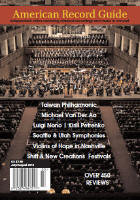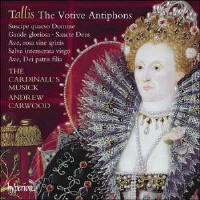Texte paru dans: / Appeared in: |
|
|
Outil de traduction ~ (Très approximatif) |
|
|
Reviewer: William
J. Gatens
The six votive antiphons of Thomas Tallis are widely regarded as the summit of his art as a composer. They are monumental in their dimensions and draw on the traditional techniques of pre-Reformation English sacred polyphony while speaking in a musical language of the composer’s time. The earliest of them date from the reign of Henry VIII and the later ones from the time of Mary Tudor, though it is impossible to date them with any assurance.
Andrew Carwood in his notes to this recording, places ‘Gaude Gloriosa’ in the time of Queen Mary based on its stylistic characteristics and the maturity of the writing. It is generally acknowledged as the greatest of Tallis’s polyphonic antiphons, but it also survives (barely) as an English contrafactum to a psalm paraphrase by Catherine Parr sung at an imposing ceremony mounted by Henry VIII at St Paul’s Cathedral in 1544. (See my review of Obsidian 716; M/J 2018.) It appears to have been a work that Tallis continued to revise and refine even after it became liturgically obsolete.
This is a compilation of tracks from five Hyperion recordings released from 2005 to 2016. Readers who have been collecting Carwood’s Tallis recordings will have these. Readers specifically interested in the votive antiphons may be pleased to find them all on a single disc. As a postscript, the program concludes with ‘O Nata Lux’, a very concise setting of two stanzas of an office hymn for the Transfiguration. It is a work at the opposite pole from the expansive elaboration of the votive antiphons.
The performances by The Cardinall’s Musick leave a mixed impression. The technical standard is very high: tight and disciplined readings by a small ensemble of outstanding early music singers. Sometimes the singers seem stretched beyond comfort by Tallis’s demanding lines. There is a keen sense of phrase trajectory without artificially imposed dynamics, but at the expense of expressive engagement. Oddly enough, the opening piece on the program, ‘Suscipe Quaeso Domine’, is treated to rich dynamic shading, so that the music seems to move in large ebbing and flowing waves of sound. It stands apart from all the other performances in this respect.
| |
|
|
|
|
Cliquez l'un ou l'autre
bouton pour découvrir bien d'autres critiques de CD |
|




